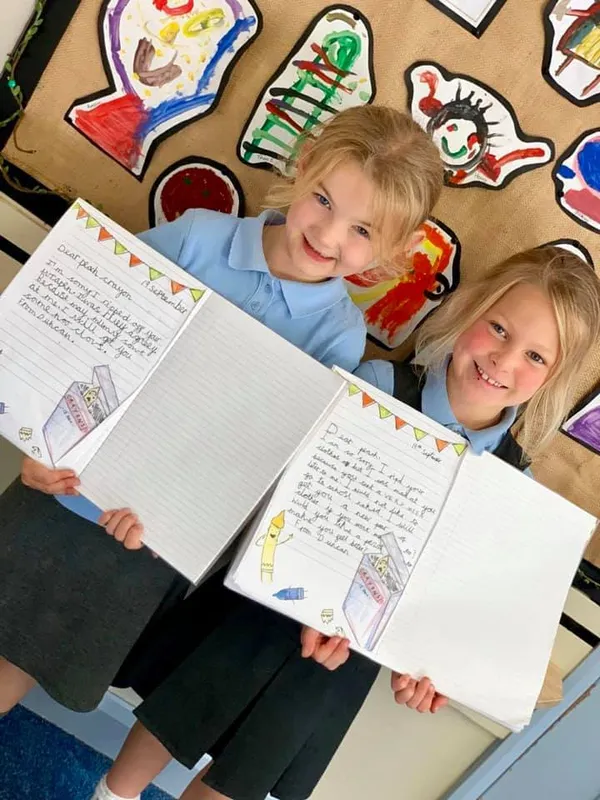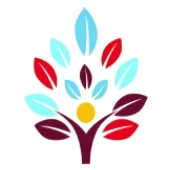



English
Writing
Our bespoke writing curriculum aims for all children to become independent, enthusiastic and lifelong writers. Children enjoy writing for real and meaningful purposes and audiences, across a range of different genres. Our writing approach is centred around carefully chosen quality core texts, which expose children to a wealth of enriched vocabulary in which they feel confident to apply across a range of contexts. Through our clear and progressive sequence of teaching, children are provided with the knowledge, skills and vocabulary to produce beautifully published writing that is of a consistently high standard.
From the moment our children come through the doors in reception, the teaching of writing will:
• Build on prior knowledge and skills, making meaningful connections with reading.
• Develop a love for writing whereby children take pride in their work.
• Provide real and exciting writing opportunities covering a range of different genres.
• Expose children to enriched vocabulary, nurturing children to enjoy using language across different contexts and in their own lives.
Our curriculum is guided by the following academic finger prints:
Children will:
• Be confident, independent and enthusiastic writers
• Apply taught grammar, punctuation and spelling when writing for a range of audiences, purposes and forms
• Be exposed to a wealth of high quality, enriched vocabulary, which they can use in different contexts
• Continuously strive to edit and improve their work.
How writing is taught:
In EYFS, our chosen Little Wandle phonics programme teaches letter formation and spelling of words. Children apply their writing skills within the phonics session and across the whole school day. In the early stages of EYFS, mark making is valued and writing is implemented in the moment, engaging children in purposeful writing through their play. Adult modelling is key to children segmenting words accurately and forming letters correctly. Environment enhancements always include opportunities for writing to encourage learning, meeting individual children’s needs.
3 C's Approach (Collect, Connect, Create)
From Year 1 to Year 6, writing is taught through the collect, connect and create (3 C’s approach). Teacher’s have the highest expectations of children’s learning throughout all stages of the writing process.

• Within the ‘Collect’ stage, children explore and learn the skills of writing through 'writing as a reader', deepening understanding and promoting spoken language. Children are exposed to high quality WAGOLL's (What A Good One Looks Like), setting the expectation of the final writing outcome and allowing children to identify key features of different genres, exploring the purpose behind why they have been used for an intended audience and purpose. Children also collect and generate high quality tier 2 and 3 vocabulary, as they 'magpie' expert words and phrases used in quality texts. Teacher's use creative and innovative teaching methods and resources to inspire children including the use of; drama techniques, interviews with real people linked to writing purpose and a range of media.
• In the ‘Connect’ stage of our learning, teachers explicitly model and support the composition of writing, manipulating the collected content into sentences using grammar skills from the national curriculum. Through guided and shared practice, children construct sentences and develop their skills, continuously improving their work through our editing sessions.
• Finally, children ‘Create’ their final published piece, after drafting sections or paragraphs of text using the writing skills taught within the connect phase. Children 'write as readers' by editing and improving their drafts before publishing a final piece for their intended purpose and audience. This produces a high quality published piece of writing with all feedback embedded.
• The importance of nurture and relationships allow teachers to ‘challenge’ children by giving them immediate, direct feedback. We put great emphasis on children taking pride in their writing and having a critical, editorial eye to create the best work they can.
• The teaching of the statutory spelling rules are implemented through a range of strategies. From direct phonic teaching in EYFS/KS1, to multi-sensory spelling approaches in KS2, our children are provided with a range of successful spelling strategies and therefore have the ability to apply them in their independent work.
Please click here to read our writing progression document

Reading
Reading is central to our whole curriculum. From the moment children enter our school, they are exposed to a wealth of high-quality texts and engaging reading experiences, feeding their imagination and instilling a lifelong love of reading.
The teaching of reading at Knayton will:
- Promote a love of reading, through teacher knowledge of high quality texts used across the curriculum.
- Obtain a word reading knowledge alongside comprehension skills in order to navigate texts and deepen their understanding of the world.
- Ensure that every child learns to read to a high standard of fluency and understanding, regardless of their background, needs or prior attainment.
- Close the ‘word gap’ by expanding pupils' vocabulary, deepening their understanding of the texts they are reading and widening their use of spoken language.
Our curriculum is guided by the following academic finger prints:
Children will:
- Be confident, skilled and rounded readers, who love reading a variety of texts
- Have a broad and balanced reading diet, where they are exposed to a range of genres and authors
- Have a secure understanding and use of spoken language, vocabulary and grammar
- Become confident with all reading domains, including vocabulary, inference, prediction, explanation, retrieval and summarising/sequencing.
How reading is taught:
- Reading is the heart beat of our EYFS classroom. We develop fluency, confidence and enjoyment of reading through a balanced approach. Adults will consistently model language, vocabulary and syntax both from books and stories, as well as throughout the day in play through our 'in the moment' approach to teaching and learning. EYFS and Year 1 receive a daily 20 minute storytelling time where children explore characters, plots, settings and themes followed by a 10 minute vocabulary session where tier 2 language is explicitly taught. This vocabulary is strategically modelled and applied across the day and revisited throughout the year. Children are also exposed to a range of poetry and develop their own narratives and stories.
- From Year 2 to Year 6, children read every day during ‘Whole Class Reading.’ They have the opportunity to listen to read individually, in pairs or in small groups once unfamiliar or challenging vocabulary has been discussed and the teacher has modelled how the text should be read.
- Throughout the week, the children read their core text, whilst also exploring other genres and texts.
- Once the text has been read, the children complete a series of questions based on the reading domain skills.
Our whole class reading lesson structure is:

Teachers encourage reading for pleasure by:
- Reading aloud to children daily
- Providing time and space for children and teachers to share their recommendations and opinions
- Using our library to explore a variety of texts in a social reading space
- Encouraging reading at home. Children take home books that closely match the letter-sound correspondences, but also are also able to take home an additional book from our Library bus or class reading corners.
- Developing children’s rich and diverse ‘reading diet’ and knowledge of literature, through expert teacher knowledge of quality texts
- Termly 'Reading Cafes' and community engagement
- Using Reading Corners linked to our core text
- Inviting therapy dogs and visitors to read with our children
- Electing school librarians to represent our school and choose new books to order
Phonics
All teachers have the highest expectation that children will become confident, fluent, proficient readers through our consistent implementation of our chosen Systematic Synthetic Phonics (SSP) Programme - Little Wandle.
Our curriculum is guided by the following academic fingerprint:
Our phonics approach will:
- Deliver a high-quality systematic synthetic phonics programme of proven effectiveness, followed with rigour and fidelity so that children are taught consistently to use phonics as the route to reading unknown words.
- Ensure pace of the phonics programme is maintained through high quality teaching and same day intervention, so that children become confident, fluent and independent readers.
- Ensure children’s reading books show a cumulative progression in phonics knowledge that match the grapheme-phoneme correspondences they know to support decoding skills, building fluency.
How Phonics is taught:
Phonics is taught through the Little Wandle programme.

Daily phonics lessons in Reception and Year 1
- We teach phonics from week 2 in Reception and use the Little Wandle Letters and Sounds Revised progression, ensuring that children build on their growing knowledge of the alphabetic code, mastering phonics to read and spell as they move through school.
- We teach phonics for 30 minutes a day. In Reception, we build from 10-minute lessons, with additional daily oral blending games, to the full-length lesson as quickly as possible.
- We follow the Little Wandle Letters and Sounds Revised expectations of progress.
Daily Keep-up lessons ensure every child learns to read
Phonics is taught in a whole class approach. Any gaps in knowledge are addressed through individual and group interventions (additional to whole class phonics sessions) from the start of the year in order for children to ‘keep up’ with their peers. Therefore, the children then move through the phase groups as one group together, Regular progress meetings are held with all reading teachers to monitor children making slowest progress. Children in danger of falling behind, or who are working behind the pace of the programme, are swiftly identified and enough additional support provided to enable them to keep up.
- Any child who needs additional practice has daily 'Keep-up' support, taught by a fully trained adult. Keep-up lessons match the structure of class teaching, and use the same procedures, resources and mantras, but in smaller steps with more repetition, so that every child secures their learning.
- We use the Little Wandle Letters and Sounds Revised assessments to identify the gaps in children's phonic knowledge and teach to these using the Keep-up resources – at pace.
Teaching reading: Reading practice sessions three times a week
- We teach children to read through reading practice sessions three times a week.
- Children read books matched to the children’s secure phonic knowledge using the Little Wandle Letters and Sounds Revised assessments.
- This decodable reading practice book is taken home to ensure success is shared with the family.
- We engage our families and share information about phonics and how children learn to blend and other aspects of our provision, both online and through workshops.
Ensuring consistency and pace of progress
- Every teacher in our school has been trained to teach early reading by Little Wandle, so we have the same expectations of progress. We use the same language, routines and resources to teach children to read so that we lower children’s cognitive load.
- Lesson templates, Prompt cards and How to videos ensure teachers all have a consistent approach and structure for each lesson.
- The Reading Leader and SLT regularly monitor and observe teaching and track progress rigorously.
The impact of our consistent and systematic teaching of our phonics programme is that children become fluent and confident readers by the age of KS1. In addition, our Phonics Screening data was 100% in 2021.
Here's what our children say:
"Reading is part of everything we do! " Katie, Year 6.
"I love publishing my work and having it displayed" Olivia, Year 2.
"We get to read our favourite books and try new ones too!". Daisy, Year 1.





